OWC Mercury Electra 3G MAX 960GB Review: 1TB of NAND in 2.5" Form Factor
by Kristian Vättö on October 18, 2012 1:00 AM ESTAnandTech Storage Bench 2011
Last year we introduced our AnandTech Storage Bench, a suite of benchmarks that took traces of real OS/application usage and played them back in a repeatable manner. Anand assembled the traces out of frustration with the majority of what we have today in terms of SSD benchmarks.
Although the AnandTech Storage Bench tests did a good job of characterizing SSD performance, they weren't stressful enough. All of the tests performed less than 10GB of reads/writes and typically involved only 4GB of writes specifically. That's not even enough exceed the spare area on most SSDs. Most canned SSD benchmarks don't even come close to writing a single gigabyte of data, but that doesn't mean that simply writing 4GB is acceptable.
Originally we kept the benchmarks short enough that they wouldn't be a burden to run (~30 minutes) but long enough that they were representative of what a power user might do with their system. Later, however, we created what we refer to as the Mother of All SSD Benchmarks (MOASB). Rather than only writing 4GB of data to the drive, this benchmark writes 106.32GB. This represents the load you'd put on a drive after nearly two weeks of constant usage. And it takes a long time to run.
1) The MOASB, officially called AnandTech Storage Bench 2011—Heavy Workload, mainly focuses on the times when your I/O activity is the highest. There is a lot of downloading and application installing that happens during the course of this test. Our thinking was that it's during application installs, file copies, downloading, and multitasking with all of this that you can really notice performance differences between drives.
2) We tried to cover as many bases as possible with the software incorporated into this test. There's a lot of photo editing in Photoshop, HTML editing in Dreamweaver, web browsing, game playing/level loading (Starcraft II and WoW are both a part of the test), as well as general use stuff (application installing, virus scanning). We included a large amount of email downloading, document creation, and editing as well. To top it all off we even use Visual Studio 2008 to build Chromium during the test.
The test has 2,168,893 read operations and 1,783,447 write operations. The IO breakdown is as follows:
| AnandTech Storage Bench 2011—Heavy Workload IO Breakdown | ||||
| IO Size | % of Total | |||
| 4KB | 28% | |||
| 16KB | 10% | |||
| 32KB | 10% | |||
| 64KB | 4% | |||
Only 42% of all operations are sequential; the rest ranges from pseudo to fully random (with most falling in the pseudo-random category). Average queue depth is 4.625 IOs, with 59% of operations taking place in an IO queue of 1.
Many of you have asked for a better way to really characterize performance. Simply looking at IOPS doesn't really say much. As a result we're going to be presenting Storage Bench 2011 data in a slightly different way. We'll have performance represented as Average MB/s, with higher numbers being better. At the same time we'll be reporting how long the SSD was busy while running this test. These disk busy graphs will show you exactly how much time was shaved off by using a faster drive vs. a slower one during the course of this test. Finally, we will also break out performance into reads, writes, and combined. The reason we do this is to help balance out the fact that this test is unusually write intensive, which can often hide the benefits of a drive with good read performance.
There's also a new light workload for 2011. This is a far more reasonable, typical every day use case benchmark. It has lots of web browsing, photo editing (but with a greater focus on photo consumption), video playback, as well as some application installs and gaming. This test isn't nearly as write intensive as the MOASB but it's still multiple times more write intensive than what we were running last year.
We don't believe that these two benchmarks alone are enough to characterize the performance of a drive, but hopefully along with the rest of our tests they will help provide a better idea. The testbed for Storage Bench 2011 has changed as well. We're now using a Sandy Bridge platform with full 6Gbps support for these tests.
AnandTech Storage Bench 2011—Heavy Workload
We'll start out by looking at average data rate throughout our new heavy workload test:
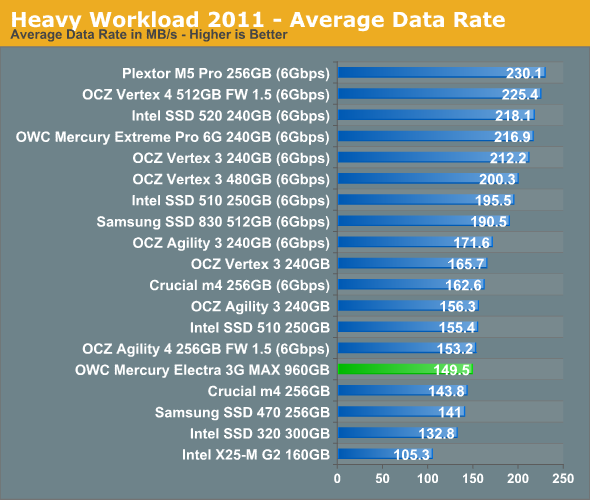
While the random performance of Mercury Electra wasn't great, it does surprisingly well in our Heavy suite. It's a bit slower than SF-2281 drives at SATA 3Gbps but it beats for example Intel's SSD 320.
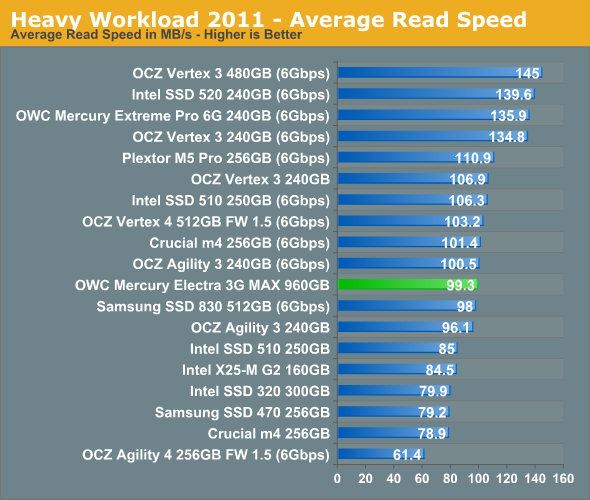

The next three charts just represent the same data, but in a different manner. Instead of looking at average data rate, we're looking at how long the disk was busy for during this entire test. Note that disk busy time excludes any and all idles; this is just how long the SSD was busy doing something:
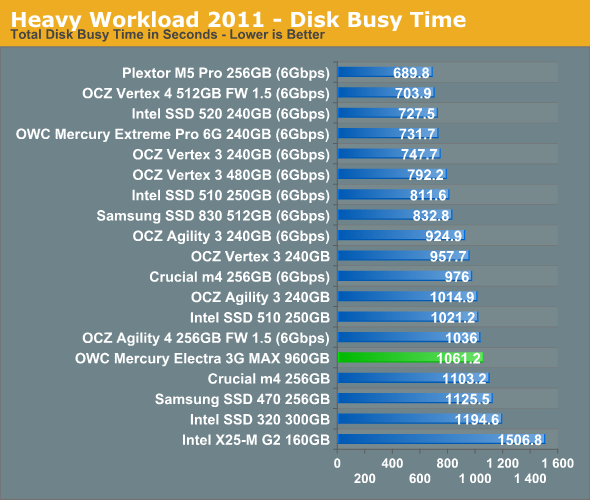
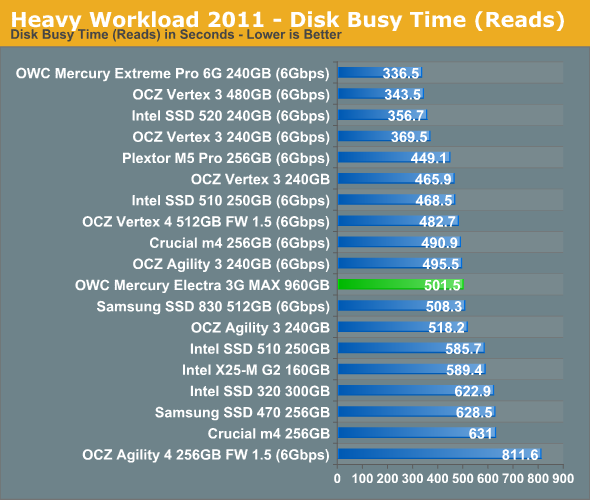
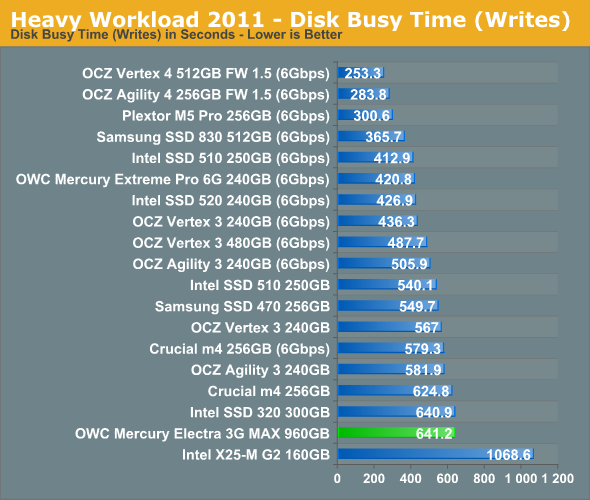










36 Comments
View All Comments
kmmatney - Thursday, October 18, 2012 - link
For most users, the "Light Workload" benchmark is probably the best indicator of real life performance, and here it performs close to a Crucial M4 running at 3Gbps. So not completely terrible (will feel much faster than any hard drive) but you really need to be using a 6Gbps controller to be competitive nowadays.ForeverAlone - Thursday, October 18, 2012 - link
Bloody hell, they're fast!To everyone who is moaning about £/GB or SSD storage, you are idiots for even considering using an SSD for storage.
HKZ - Thursday, October 18, 2012 - link
Maybe for big projects and similar things it's pretty dumb for a regular user, but with games about 10GB or so even on a 256GB SSD you can stuff a lot of games on there!HKZ - Thursday, October 18, 2012 - link
I have an OWC 240GB SSD SATA 3, and it's pretty fast, but at 1TB of space at this price this performance is dismal. I'm saving up for a Samsung 830 (maybe an 840) for the extra space and speed. I only use about 60GB of that 240 for OS X, and the rest for Windows 7. With a 512GB I'd have all kinds of space for my games. Yes, I game on a MacBook and I know it's not the best but it's all I've got right now. Don't kill me in the comments! XDI've got that SSD and a 1TB HDD taking the optical drive spot in my 2011 MBP and there's no way I'd pay a third of the price of my already very expensive machine for an SSD that slow. Someone will buy it, but I can't wait for an affordable 1TB SSD.
Lord 666 - Thursday, October 18, 2012 - link
Think as an iSCSI target for VSA or DAS using an older but still relevant HP DL380 G6 or G7. The 3g connection will be fine and overall performance will be much faster than 1tb SATA not to mention much cheaper than 1tb SAS.JarredWalton - Thursday, October 18, 2012 - link
But will it be reliable long-term? That's someone no one really knows without extended testing in just such a scenario.poccsx - Thursday, October 18, 2012 - link
Not a criticism, just curious, why is the Samsung 840 not in the benchmarks?Kristian Vättö - Friday, October 19, 2012 - link
I made the graphs before we had the 840, that's why (but then this got pushed back due to the 840/Pro reviews). You can always use Bench to compare any SSD to anotherciparis - Friday, October 19, 2012 - link
- it's not affordable- it's not remotely efficient
- it's quite slow
This seems like a company out of it's depth, producing a product it should have cancelled outright when the numbers became clear (it's no wonder they don't want to talk about them). Note that I'm giving them the benefit of the doubt and assuming these numbers weren't what they set out to create; if I'm wrong about that it's perhaps even more damning.
melgross - Friday, October 19, 2012 - link
You shouldn't assume, because you don't know. I wouldn't be surprised if there is a fair amount of demand for this in a laptop despite the price, performance or power draw. Some laptops have a pretty good battery life around 7 hours or so that would still have decent battery life with one of these.OWC is right that this is a good job for video editing on a laptop, and professional use for dailies in the field would be a perfect use for this.
As far as criticism of the performance goes, I remember plenty of guys here talking about how they were going to buy drives a year or two ago that had performance that was much worse for much smaller drives at a higher price per Gb. If you're loading or saving fairly large projects, a doubling of performance is very significant.
Of course, if you never have done any of that, you won't understand it either.